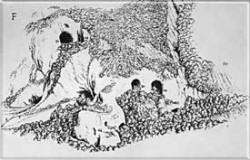|
|
|
| The New Monsegur - an Underground Epic |
 In his book ‘The Heritage of the Cathars’, Antonin Gadal gives us a detailed account of the agony of the last Cathars, and of the ‘faydits’ who, chased and tracked by the seneschal and the inquisition’s troops, were going to die slowly immured in the cave of Lombrives. In his book ‘The Heritage of the Cathars’, Antonin Gadal gives us a detailed account of the agony of the last Cathars, and of the ‘faydits’ who, chased and tracked by the seneschal and the inquisition’s troops, were going to die slowly immured in the cave of Lombrives.
In 1328, well after the death of Amiel Aicard and Loup de Foix (another Cathar perfect, related to the House of Foix) who had made of Lombrives his oratory and sanctuary to meditate and pray, Gadal tells us, this famous cavern - the place of so many nightly predications - had become for the faydits of the wood a permanent refuge from the increasing storm of the hatred of the Inquisition. Five or six hundred mountainers, fugitives - men, women and children - had settled in the darkness and had formed around the Cathar priest a mixture of mystical colony and wild camp.
‘A new Montségur’ had been organised, not chivalrous anymore like the other one perched in the clouds, but on the contrary, rustic and lost in the womb of a mountain, an abyss crossed by a diluvian torrent.
The Seneschal’s troops decided to destroy that den of “believers”. They had previously taken and demolished the ‘three Churches’ of Ussat, Ornolac and Bouan. They got into the cave through the narrow entrance but did not know that the cave was double and that its eastern corridor is only the vestibule of an upper gallery, four times deeper and which forms the mother cave. It is reached through an eighty meters high escarpment. Taking off one after the others the ladders put up on some protruding entablatures, the Cathars were, for a moment, impregnable in the darkness. Thinking they would drive them back into the Cathedral to massacre them, the Catholic troops had to withdraw.
They then walled the narrow neck, and the outside exits. ‘The cave remained “sealed and scourged”, cursed and forbidden by the superstitious awe that surrounded it, like an undefinable mixture of mystery, inexpiable crime and royal and priestly ban.’
|
 |
|
|
|
|




